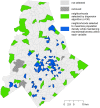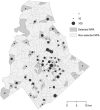A Novel Sampling Method to Measure Socioeconomic Drivers of Aedes Albopictus Distribution in Mecklenburg County, North Carolina
- PMID: 30301172
- PMCID: PMC6210768
- DOI: 10.3390/ijerph15102179
A Novel Sampling Method to Measure Socioeconomic Drivers of Aedes Albopictus Distribution in Mecklenburg County, North Carolina
Abstract
Climate change, urbanization, and globalization have facilitated the spread of Aedes mosquitoes into regions that were previously unsuitable, causing an increased threat of arbovirus transmission on a global scale. While numerous studies have addressed the urban ecology of Ae. albopictus, few have accounted for socioeconomic factors that affect their range in urban regions. Here we introduce an original sampling design for Ae. albopictus, that uses a spatial optimization process to identify urban collection sites based on both geographic parameters as well as the gradient of socioeconomic variables present in Mecklenburg County, North Carolina, encompassing the city of Charlotte, a rapidly growing urban environment. We collected 3,645 specimens of Ae. albopictus (87% of total samples) across 12 weeks at the 90 optimized site locations and modelled the relationships between the abundance of gravid Ae. albopictus and a variety of neighborhood socioeconomic attributes as well as land cover characteristics. Our results demonstrate that the abundance of gravid Ae. albopictus is inversely related to the socioeconomic status of the neighborhood and directly related to both landscape heterogeneity as well as proportions of particular resident races/ethnicities. We present our results alongside a description of our novel sampling scheme and its usefulness as an approach to urban vector epidemiology. Additionally, we supply recommendations for future investigations into the socioeconomic determinants of vector-borne disease risk.
Keywords: health disparities; optimization; social determinants of health; vector-borne disease.
Conflict of interest statement
The authors declare no conflicts of interest.
Figures








References
-
- Dash A.P., Bhatia R., Sunyoto T., Mourya D.T. Emerging and re-emerging arboviral diseases in Southeast Asia. J. Vector Borne Dis. 2013;50:77–84. - PubMed
-
- Romanović M., Zorić I. Breeding habitat diversity of medically important mosquitoes and the risk of spreading exotic species in the coastal area of Croatia. Period. Biol. 2006;108:15–19.
-
- Seng C.M., Jute N. Breeding of Aedes aegypti (L.) and Aedes albopictus (Skuse) in urban housing of Sibu town, Sarawak. Southeast Asian J. Trop. Med. Public Health. 1994;25:543–548. - PubMed
Publication types
MeSH terms
LinkOut - more resources
Full Text Sources
Molecular Biology Databases

